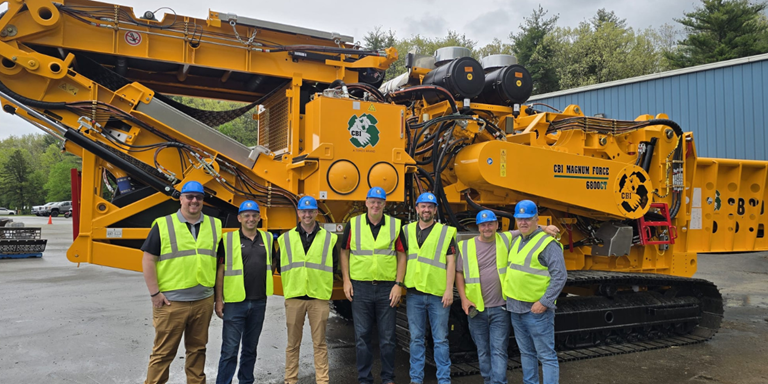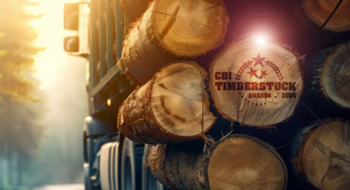JEWETT CITY, CT – Southeastern Connecticut Regional Resource Recovery Authority (SCRRRA) was established through the state’s legislature in 1987 to serve twelve towns in the southeastern part of the state. The idea was to create long-term solutions for waste and pass value along to the residents. Under this collective model, member municipalities deliver a minimum amount of solid waste to SCRRRA’s waste-to-energy burn plant in Preston, CT to be processed for a small fee. The Authority also manages a closed ash landfill, provides assistance for new and existing recycling programs, maintains educational recycling programs, and offers an array of waste management services.
They’ve grown and continually adapted over the years to execute their mission.
SCRRRA grinds brush for member municipalities at no cost and sells backyard compost so that residential organics can be responsibly composted. As a result, anyone demonstrating proof of residency to one of the twelve towns can dump brush and tree trimmings free of charge. By collecting and grinding yard waste, SCRRRA is able to make a significant environmental impact while selling the end-product to larger manufacturers.
It’s beneficial for all stakeholders.
On top of providing this great value to residents, the Authority also bears the responsibility of removing contamination and properly disposing of organics. They combat the issue with educational outreach and the latest equipment innovations.
Educational outreach
SCRRRA is extremely committed to reducing contamination along every stage of the waste management process. The Authority offers recycling education classes to provide residents with a background on composting, recycling, solid waste, and household hazardous waste. They also offer presentations, backyard composting demonstrations, a trash relay, recycling jeopardy, and school composting outreach programs.
Their free educational class covers the subject matter in the broader environmental and scientific framework. Modules are flexible depending on topic, age, and class size to engage attendees.
One of their most interesting tactics to instill new habits in residents is the gamification of recycling education, which includes an interactive “SCRRRA Recycling Challenge” online game. The waste sorting game lets players drag and drop various materials between the transfer station, backyard compost, recycling bin, garbage can, and hazardous waste options. It’s a fun way to raise the baseline understanding of “what goes where” and encourage residents to adopt new behaviors.
Recognizing the importance of preventing contamination upstream, at the household level, SCRRRA’s educational programs aim to have a lasting impact.
But they still have to be prepared for and manage tramp metal in raw material.
“We’ve seen everything in the brush piles from the kitchen sinks to the lally columns used in basements,” explained Lenny Weise, who operates the horizontal grinder for SCRRRA. “Sometimes there are car parts in the brush piles. What anybody can put in the back of their pickup truck, they dump in the piles.”
BioCycle’s State of Organics Recycling in the U.S. report indicates that at least 62 percent of composting facilities in the United States process raw yard trimmings and brush—similar to what’s dropped off at the transfer stations served by SCRRRA. Of the 35 states reporting, 14.4 million tons of yard trimmings were diverted per year and represented the largest diverted category of material in America.
Properly diverting tramp metal from yard waste represents a massive opportunity for the country to reduce compost contamination, and equipment manufacturers are responding with innovation.
Equipment innovations
SCRRRA recently upgraded to a CBI 6800CT Horizontal Grinder, which has been developed for wood-waste professionals who need to process high-volumes of the toughest materials and detect any metal mixed into piles.
Weise immediately noticed the improvement in production, performance, and durability of the 6800CT compared to other grinders. A trailer hitch was hiding in a brush pile he was grinding in Griswold, CT when it was loaded into the grinder. When the hitch made contact with the rotor, electronic sensors alerted the control system and reversed the infeed. The top feed roll raised automatically and the hitch was able to be easily located and removed. There was no damage to the machine, not even a single broken tooth. Minutes later, they were back up and running.
“You can put a lot more in a CBI compared to the other machines that I’ve run and they seem to hold up to everything I do to them,” Weise said. “It’s just an aggressive, mean machine when it comes to grinding wood. It’s just built like a tank.”
MDS systems may seem like old news, but advancements and state-of-the-art precision offer next level performance.
CBI’s Metal Detection System (MDS) is alert enough to detect a bag of bolts in a plastic sandwich bag. The MDS uses an accelerometer to detect and monitor the rotor’s vibration patterns, picking up the unique harmonic frequency of metal hitting metal and translating the change to a user dashboard mounted on the side of the machine. Milliseconds after tramp metal strikes the rotor, the MDS system automatically stops the rotor, raises the top feed roller, reverses the infeed, sets the engine to an idle, and goes into a controlled shutdown of the machine. This pre-measure prevents damage to the machine long before it becomes an issue.
Beyond the obvious cost savings advantage of protecting the grinder, the MDS is an excellent method of diverting metal during the primary grind stage of composting. An intuitive display screen lets the end user set “trip point” sensitivity on a scale of zero to five, tailoring the system to the application.
Frank Franciosi, Executive Director of the United States Composting Council, has personally experienced the havoc that tramp metal can cause to an operation and underscores the industry-wide importance of tramp metal diversion.
“Contamination reduction is a big focus in the industry and it’s great anytime you can pull something out before it ends up in the final product,” Franciosi said. “You want to catch it upstream before it breaks up into smaller pieces that could make it into the compost which can devalue the product. From a safety and equipment standpoint, it’s critical to remove pieces of metal from a waste pile to prevent the next employee or piece of equipment from encountering it.”
As a secondary measure, CBI grinders come with the option to have magnets installed. These various types of magnets are designed to pull nails from shingle grinding applications or collect smaller bits of metal coming off the discharge belt.
High-production and premium quality
SCRRRA will be using their new 6800CT as part of a mobile storm debris response plan. The yellow monster is designed to process land clearing debris, pallets, clean industrial waste, stumps, logs, mulch, bark, shingles, and whole trees as fast as it can be loaded, producing valuable end-product and giving Weise command over intense deadlines.
Across the United States, many composters run material through horizontal grinders in their approach to break down, turn, and blend the primary grind. The 6800CT’s rotor has a 15 percent larger screening area, wrapping more than 190 degrees around the rotor and allowing production rates to surge beyond 200 tons an hour—an innovation for yard waste processors who want to produce high volumes at the lowest possible cost per ton.
Weise explained that SCRRRA will use their grinder mostly for primary size reduction. The grinder will also be deployed for preventative measures. Their increased production capacity means processing the brush piles faster and reducing the risk of fire.
“Towns are going to see a very big improvement in how neat their transfer stations are and there’s going to be a lot less worries about the brush piles catching on fire,” Weise explained. “If there’s a hurricane or tornado, we can go out and help.”
Many of the brush piles contain various sized materials from small yard waste to large diameter wood from the local town crews.
The 40” diameter x 60” wide upturn rotor has a forged, thick, high-strength core with 24 weld-on hammers. The offset helix pattern cuts the full width of the rotor, distributing material across the hammers for natural efficiency. Complete with interchangeable tips that bolt on and a grinding chamber that opens for quick screen changes, the machine is friendly to operators who want to go from attacking brush to whole trees in minutes.
Producing a consistent end-product is key to their operation’s ability to sell and recycle mulch and compost. Their program will offer the benefit to residents for years to come and serves and an aspirational model that can be replicated across the country.
SCRRRA’s member municipalities include East Lyme, Griswold, Groton, Ledyard, Montville, New London, North Stonington, Norwich, Preston, Sprague, Stonington, and Waterford. To learn more about SCRRRA and their various programs, visit www.scrrra.org.





